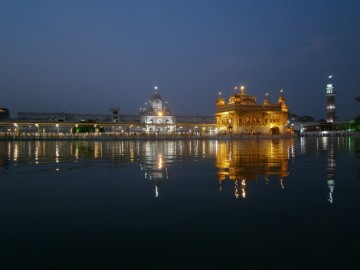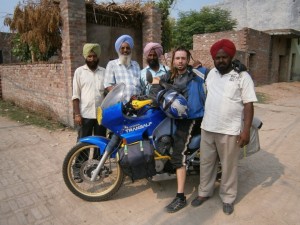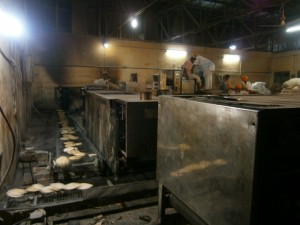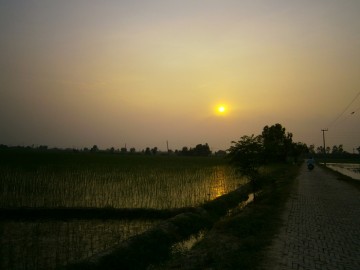[:it] A raccontare di Amritsar non si può non cominciare descrivendo lo stupefacente Tempio d’Oro, la più importante meta di pellegrinaggio della religione Sikh, l’ultima nata tra le religioni del mondo nel XV secolo.
A raccontare di Amritsar non si può non cominciare descrivendo lo stupefacente Tempio d’Oro, la più importante meta di pellegrinaggio della religione Sikh, l’ultima nata tra le religioni del mondo nel XV secolo.
E’ impressionante: tutta la città di Amritsar è organizzata per accogliere le migliaia di pellegrini che qui si radunano ogni giorno. La tangenziale sopraelevata finisce direttamente all’interno di un parcheggio dedicato esclusivamente a loro, e di fronte all’ingresso del tempio c’è un grande parcheggio sotterraneo per le moto completamente gratuito. Per entrare nel tempio poi bisogna togliersi le scarpe e coprirsi la testa in segno di rispetto, uomini compresi.
All’interno del gigantesco edificio in marmo bianco si trova una piscina di acqua sacra nel cui centro brilla un edificio più piccolo completamente d’oro.
La caratteristica che salta più all’occhio degli adepti di questa religione sono i colorati turbanti indossati dagli uomini,  con cui proteggono i lunghi capelli che, secondo il loro credo, non dovrebbero essere mai tagliati durante tutto il corso della vita. Altri oggetti che devono sempre portare con se sono: un pettine, per tenere i capelli sempre in ordine, un braccetto, simbolo di fratellanza e un pugnale, spesso portato in un fodero a tracolla.
con cui proteggono i lunghi capelli che, secondo il loro credo, non dovrebbero essere mai tagliati durante tutto il corso della vita. Altri oggetti che devono sempre portare con se sono: un pettine, per tenere i capelli sempre in ordine, un braccetto, simbolo di fratellanza e un pugnale, spesso portato in un fodero a tracolla.
Essendo questo il luogo più sacro della religione Sikh, ogni credente deve prestarvi servizio per almeno una settimana durante il corso della sua vita e la varietà di lavori disponibili sono veramente tanti: dal preparare e servire il cibo al tenere pulito l’enorme complesso. All’interno del tempio 24 ore su 24 viene offerto cibo, acqua e chay, volendo vi sono stanze dove poter dormire e tutto questo è gratis.
 Dobbiamo ammettere che essendo Amritsar e il Tempio d’oro la nostra prima esperienza di India non eravamo assolutamente preparati a niente di simile. Ci siamo ritrovati a vagare per ore senza mai stancarci osservando gli anziani pellegrini vestiti in abiti tradizionali appoggiati a lunghe lance (i Sikh storicamente furono una comunità di guerrieri), abbiamo poi avuto la fortuna di incontrare un anziano signore che ci ha accompagnato a scoprire il tempio fino alle sue cucine dove una gigantesca macchina dotata di nastro trasportatore impastava, spianava e cuoceva decine di chapati al minuto. E noi sempre lì con gli occhi spalancati a non sapere dove guardare tanto ce n’era…
Dobbiamo ammettere che essendo Amritsar e il Tempio d’oro la nostra prima esperienza di India non eravamo assolutamente preparati a niente di simile. Ci siamo ritrovati a vagare per ore senza mai stancarci osservando gli anziani pellegrini vestiti in abiti tradizionali appoggiati a lunghe lance (i Sikh storicamente furono una comunità di guerrieri), abbiamo poi avuto la fortuna di incontrare un anziano signore che ci ha accompagnato a scoprire il tempio fino alle sue cucine dove una gigantesca macchina dotata di nastro trasportatore impastava, spianava e cuoceva decine di chapati al minuto. E noi sempre lì con gli occhi spalancati a non sapere dove guardare tanto ce n’era…
Questo è il nostro [ video ] del tempio d’oro di notte, quando tutti dormono dove capita e la città tutt’intorno è completamente silenziosa e deserta, per strada si incontrano solo mucche e cani randagi che ravanano, fianco a fianco, nella spazzatura alla ricerca di cibo (come si vede in quest’altro [ video ]).

Riguardo a noi, ad Amritsar siamo stati ospitati da Mr. Singh nella sua fattoria in mezzo alle risaie riconvertita in ristorante e albergo. Qua le stanze sono gratis e paghi solo se mangi o bevi qualcosa. Questo si che è un buon inizio!
Niente poteva metterci più di buon umore che lunghe passeggiate al tramonto fra le risaie mentre i contadini riportano i bufali a casa. Questo il [ video ] del nostro arrivo alla fattoria, che oltretutto è anche il dietro le quinte della foto di Thomas con i 4 Sikh.[:en] Amritsar’s main turistic attraction is the Golden Temple, the most important pilgrimage site for the Sikh religion. This is the last religion that was found on earth in the XV century.
Amritsar’s main turistic attraction is the Golden Temple, the most important pilgrimage site for the Sikh religion. This is the last religion that was found on earth in the XV century.
The Golden Temple is impressive: the whole city of Amritsar is organized to welcome thousands of pilgrims every day. The flyover ends directly inside a parking lot reserved only for pilgrims; in front of the entrance of the Temple there is a big underground motorbike park completely free. To go inside the Temple everybody have to take off their shoes and cover their head to show respect, men included.
Inside the huge building made of white marble there is a big pool of holy water and in the middle of it shines a smaller building completely covered of gold.
The most visible caratheristic of its devotees is that men wear colorful turbants in which they protect their long hair that,  according to their beliefs, they should not cut during their whole life. The other things that they always have to have on them are: a comb, to keep their hair always clean, a bracelet, symbol of fraternity and a dagger in a scabbard on a shoulder strap.
according to their beliefs, they should not cut during their whole life. The other things that they always have to have on them are: a comb, to keep their hair always clean, a bracelet, symbol of fraternity and a dagger in a scabbard on a shoulder strap.
Being this the most sacred place for the Sikh religion every believer have to serve here for at least one week during their life and the variety of jobs that you can do it’s really wide: cooking and serving food or else cleaning the huge complex. Inside the temple is offered food, water and chay 24/7, if needed there are also rooms where you can sleep. And all this is for free.
 We have to admit that, being Amritsar and the Golden Temple our first experience of India we were absolutely not ready for something like that. We found ourself meandering for hours, never tired, looking at the old pilgrims dressed in the traditional clothes leaning on long spears (historically the Sikh were a community of warriors). We were lucky enough to meet an old man that showed us around the temple, even inside the kitchen, where a huge machine with a conveyor belt kneded, rolled out and cooked hundreds of chapati per minute. And us, always looking araound with eyes wide open, with so much to see that we didn’t know where to look…
We have to admit that, being Amritsar and the Golden Temple our first experience of India we were absolutely not ready for something like that. We found ourself meandering for hours, never tired, looking at the old pilgrims dressed in the traditional clothes leaning on long spears (historically the Sikh were a community of warriors). We were lucky enough to meet an old man that showed us around the temple, even inside the kitchen, where a huge machine with a conveyor belt kneded, rolled out and cooked hundreds of chapati per minute. And us, always looking araound with eyes wide open, with so much to see that we didn’t know where to look…
This is our [ video ] of the Golden Temple by night, when everybody is sleeping wherever they find a place and the town around is silent and empty, on the street we met only cows and street dogs rummaging side by side in the garbage looking for food (as you can see in this other [ video ]).

In Amritsar we were hosted by Mr. Singh in his farm in the middle of the paddy fields, now converted into a restaurant and hotel. Here rooms are free, you pay only if you eat or drink something. This is definetely a good start!
Nothing could have put us in a better mood than strolls at sunset between rice fields while farmers walk their buffalos back home. This is the [ video ] of our arrival at the farm, which is also the making of the picture of Thomas with the 4 Sikh.[:]
![[:it]Sulla Terra e nel Vento[:en]Overland within the Wind[:]](http://longaterra.net/300kg/wp-content/uploads/sites/15/2016/08/nuovoheaderlogo.jpg)